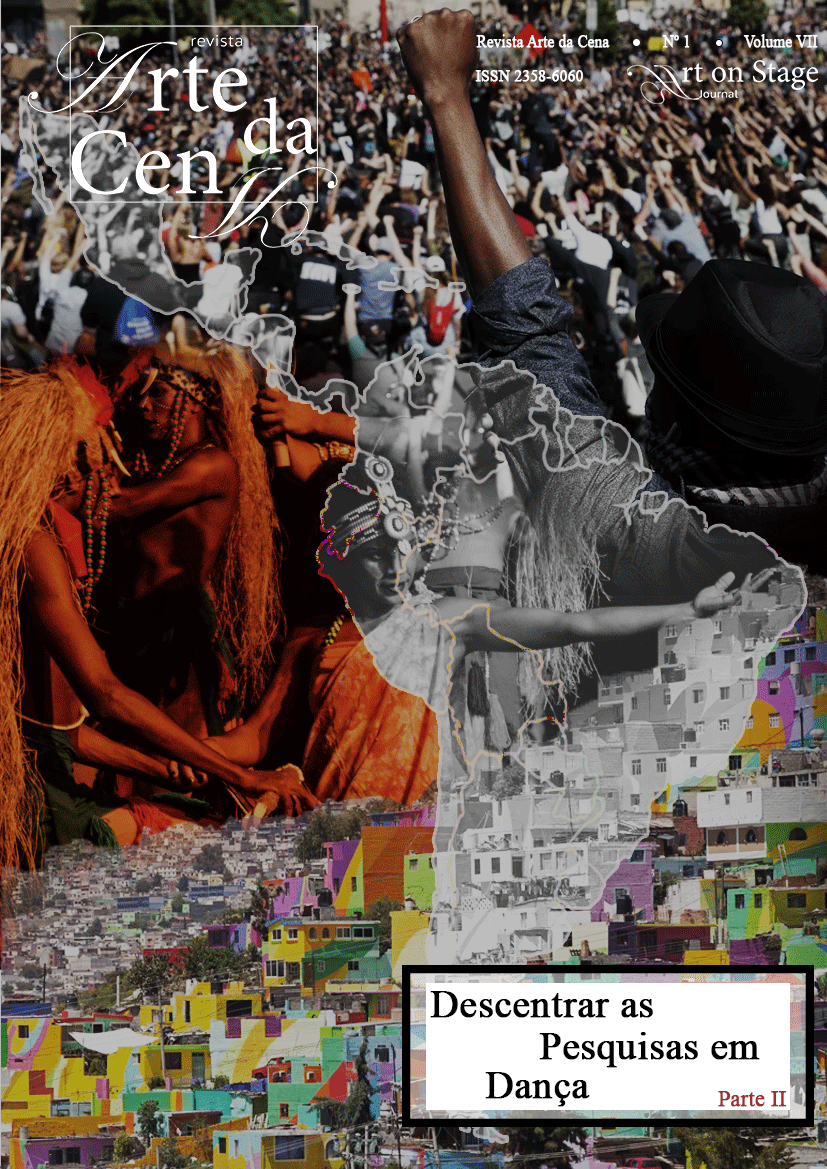The Benesh movement notation system as an analytical tool for a decentered approach in dance research
Case of the dance of Exú in the Candomblé in Brazil
DOI:
https://doi.org/10.5216/ac.v7i1.68790Abstract
Through the presentation of the project A Boca do Mudo, developed around the Exú dance at Candomblé in Brazil, we highlight the process of writing a movement score and the questions faced by the notator when on the field. Within a research approach, this postulate questions the advantages and limits of using the Benesh movement notation system in the context of ritual dances of oral tradition. This system, in contrast to the conservative function that it has for certain uses – and because it forces the notator to question his own posture and his own knowledge – proves its potential to evolve and decentralize points of view in dance research.
Downloads
References
BENESH, Joan; BENESH, Rudolf. Introduction to Benesh Movement-notation: Dance. New York: Dance Horizons Inc., 1969.
BENESH, Joan; BENESH, Rudolf. Reading Dance: Birth of Choreology. Oxford: Souvenir Press, 1977.
CAVE, Richard; WORTH, Libby (ed.). Ninette de Valois: Adventurous Traditionalist. London: Dance Books, 2012.
GLON, Marie. Les Lumières chorégraphiques : les maîtres de danse européens au cœur d’un phénomène éditorial (1700-1760). Paris : École doctorale de l’École des hautes études en sciences sociales, 2014. Doctorat en Histoire et civilisations.
GRAU, Andrée, WIERRE-GORE, Georgiana (éd.). Anthropologie de la danse. Genèse et construction d’une discipline. Pantin : CND, 2006.
HALLOY, Arnaud. Divinités incarnées : l’apprentissage de la possession dans un culte afro-brésilien. Collections Anthropologiques, Paris : éditions Petra, 2015
HUGUES RYMAN, Robyn, RYMAN-KANE, Rhonda. Benesh for Ballet, books 1 to 4. DanceWrite, 2017.
HUTCHINSON GUEST, Ann. Choreo-graphics: a comparison of dance notation systems from the fifteenth century to the present. Singapore: Gordon and Breach, 1989.
INMAN, Tania (éd.). Benesh movement notation score catalogue: an international listing of Benesh movement notation scores of professional dance works recorded 1955-1998. London: The Benesh Institut, 1998.
KAEPPLER, Adrienne Lois. Méthode et théorie pour l’analyse structurale de la danse avec une analyse de la danse des îles Tonga. In : GRAU, Andrée; WIERRE-GORE, Georgiana (éd.). Anthropologie de la danse. Genèse et construction d’une discipline. Pantin : CND, 2006.
LODY, Raul; SABINO, Jorge. Danças de matriz africana: antropologia do movimento. Rio de Janeiro: Pallas, 2011.
MCGUINNESS-SCOTT, Julia. Movement Study and Benesh Movement Notation: An Introduction to Applications in Dance, Medicine, Anthropology, and Other Studies. Oxford: Oxford University Press, 1983.
MIRZABEKIANTZ, Éliane. Comment la notation Benesh relève et révèle l’interprétation. In: La Revue du Conservatoire: Dossier notation et interprétation, No. 1, mis en ligne le : 18/07/2013 URL : http://larevue.conservatoiredeparis.fr/index.php?id=298.
MIRZABEKIANTZ, Éliane. Grammaire de la notation Benesh. Pantin : CND, 2000.
MIRZABEKIANTZ, Éliane, PANASSIÉ, Romain. Choréologue Benesh : un métier au cœur de la transmission des œuvres chorégraphiques. In: La Revue du Conservatoire : Sources – Traditions – Inspirations, No. 7, mis en ligne le : 05/06/2019 URL : http://larevue.conservatoiredeparis.fr/index.php?id=2032.
PANASSIÉ, Romain. La partition chorégraphique comme moyen d’accès à l’œuvre et source de collaborations artistiques, La Revue du Conservatoire, No. 5, mis en ligne le : 05/07/2017 URL : http://larevue.conservatoiredeparis.fr/index.php?id=1625.
PENMAN, Robert; WATTS, Victoria. De Valois’ Role in the Development and Dissemination of Benesh Movement Notation. In: CAVE, Richard; WORTH, Libby (ed.). Ninette de Valois: Adventurous Traditionalist. London: Dance Books, 2012, pp. 124–129.
VAN ZILE, Judy. Noter la danse: Comment et pourquoi?. SUQUET, Anne (trad.), In: GRAU, Andrée, WIERRE-GORE, Georgiana (éd.). Anthropologie de la danse. Genèse et construction d’une discipline. Pantin : CND, 2006.
VATIN, Xavier. Rites et musiques de possession à Bahia. Collection recherches Amériques Latines, Paris : L’Harmattan, 2005.
WATTS, Victoria. Benesh Movement Notation and Labanotation: From Inception to Establishment (1919–1977). In: Dance Chronicle, 38/3, pp. 275-304, 2015.
WILLIAM, Rodney. L’appropriation culturelle. collection Epoca, la diversité des voix brésiliennes, éditions Anacaona, 2020. Titre original: Apropriação Cultural, Jandaíra, 2019
royalacademyofdance.org/benesh-international-benesh-movement-notation/benesh-training-centre/
conservatoiredeparis.fr/etudes/diplomes-delivres/danse/#c1062
akts.hacettepe.edu.tr/
Downloads
Published
Versions
- 2021-07-30 (2)
- 2021-07-29 (1)
How to Cite
Issue
Section
License
Copyright (c) 2021 Helena Sampaio van Riemsdijk, Classe Johanna

This work is licensed under a Creative Commons Attribution-NonCommercial 4.0 International License.
The Art on Stage Journal uses the Creative Commons - Attribution-Non-Commercial 4.0 International license as a basis for transferring rights, for open access journals (Open Archives Initiative - OAI).
Authors who publish in this journal agree with the following terms:
1) Authors retain the copyright and grant the Art on Stage Journal the right to first publication, with the work simultaneously licensed under the Creative Commons Attribution Non Commercial License.
2) Authors are authorized to assume additional contracts separately, for non-exclusive distribution of the version of the work published in this Journal (eg, publishing in institutional repository or as a book chapter), with acknowledgment of authorship and initial publication in this journal.
3) Authors are allowed and encouraged to publish and distribute their work online (eg in institutional repositories or on their personal page) at any point before or during the editorial process, provided that the reference to the place of publication is cited, that is, the electronic address / reference of Art on Stage Journal.
4) The authors of the works published in the Art on Stage are expressly responsible for their content.
5) Authors will not be paid for publication of works in the Art on Stage Journal.



